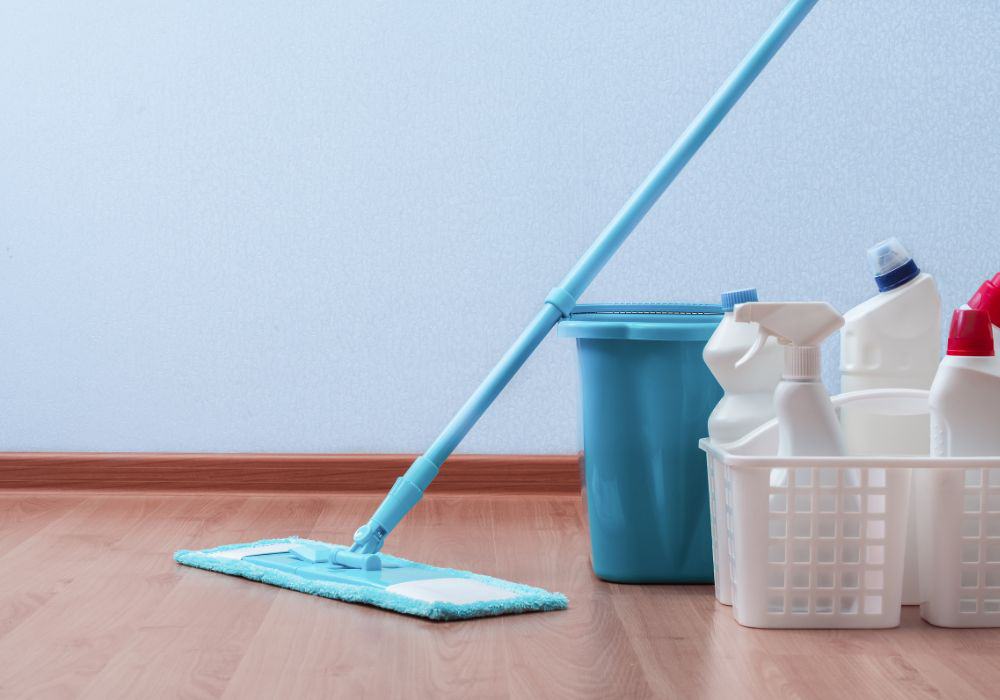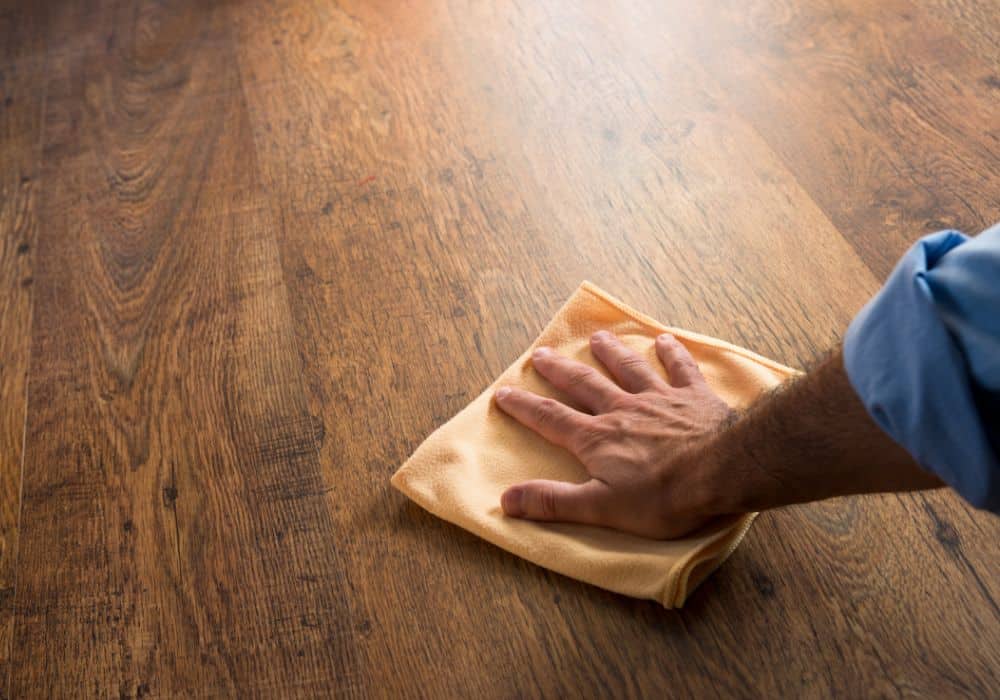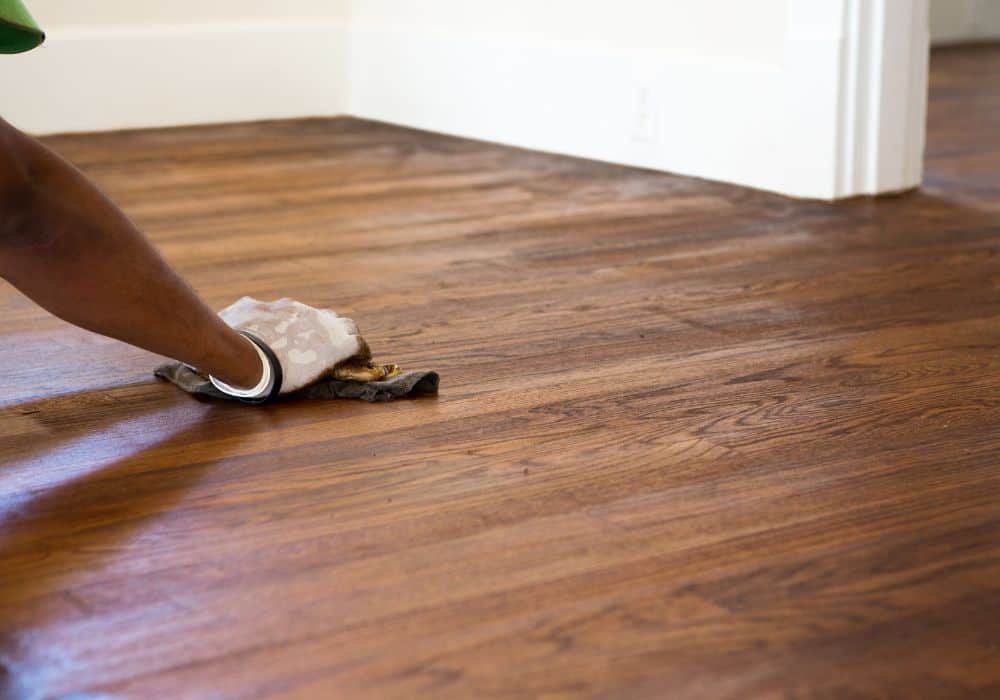Bleach is a common household item frequently used for cleaning and disinfecting. It controls or kills most kinds of bacteria, viruses, mildew, molds, etc. But can you use bleach on hardwood floors, and is it a safe cleaning option?
Let’s get into the topic and answer your question while discussing everything you need to know about cleaning hardwood floors. First, let’s get stuck on the main question!
Table of Contents
Can You Use Bleach on Hardwood Floors?
The answer to your question is no. You cannot use bleach on hardwood floors because it can break the wood’s finish and seep through its porous fibers. This can lead to discoloration, weaken the wood, and also cause the wood to warp.
Bleach is a powerful disinfectant chemical often used for whitening clothes. It’s also ideally used for sanitizing toilets and removing stains. But despite it being a useful solution for the household, it isn’t always the best option for every scenario.
Regarding flooring, we usually recommend bleaching for non-porous surfaces or finished wood surfaces only. If you aren’t sure about non-porous surfaces, these include linoleum, ceramic tiles, and vinyl.
It’s also good to note that you should never use bleach on any marble surface. Plus, always dilute bleach when using it to clean hard surfaces.
Ideal Uses for Bleach
If you can’t use bleach for your floors, what can you use it for? Let’s take a look.
- Cleaning Cutting Boards – Cutting boards and butcher-block countertops can accumulate a lot of bacteria as time passes. To clean these with bleach, combine a teaspoon of it with two quarts of water. Next, dip a brush into the mixture, then use small circular motions to scrub the counter and boards. After, wipe the areas with a damp paper towel and dry them immediately.
- Painted Sidings and Surfaces – For these areas, mix a quarter of bleach with two cups of water. With a brush, apply the mixture on any areas showing these problems, then allow it to set for 15 minutes before rinsing. You may need to repeat the process if there are still some mildew/mold remnants.
- Cleaning Shower Curtains – Cleaning your shower curtains with bleach is easy. You only need to wash it in warm water with half a cup of bleach. Next, add a quarter cup of detergent, then let the washer run for a couple of minutes before drying at low for 10 minutes.
- Cement or Stucco – To clean cement or stucco, just mix a cup of bleach with two gallons of water. After, scrub the area using a stiff-bristled brush before rinsing.
- Brightening White Linen – Out of all these, the most popular use for bleach will be intensifying and brightening white fabric. You can use it for white clothes, linen, duvets, curtains, and sheets. Use the hottest water setting available on your washing machine before adding a cup of bleach. Allow your linens to soak in for five minutes before adding half a cup more bleach plus your favorite detergent. After that, run a regular cycle.
- Bringing Back the Sparkle in Your Glass Dishes – If you’re having problems with water stains on your glass dishes, you can use bleach to remove them. Aside from removing the stains, it can also help brighten up the glass. You can add a teaspoon of bleach to soapy and hot dishwater. Then, wash, rinse, and dry the dishes as usual. Once done, you’ll see your dishes sparkling like brand new!
The Best Hardwood Floor Cleaner
You can’t use bleach, so what can you use for your hardwood floors? While there are floor cleaners specifically made for this reason, all you really need is good old soap and water to get them clean.
While it can be difficult to remove stains with this solution, it’s one that will protect the surface and keep the wood looking its best. That being said, you want to keep any water use to a minimum and ensure that the wooden floor is sealed.
To make your life easier, you can get a mop made specifically for hardwood floors. These allow you to easily control the water and keep your floors looking pristine. Read on to see how to clean your floors in a little more detail.
How to Clean Hardwood Floors
Here are a few things you need to see and make sure of before cleaning your hardwood floor:
Step1. Check Your Floor to see if it’s Sealed
It’s important to know the type of finish applied to your flooring. If a drop of water stays on the surface, your floor is sealed so you can clean it with a water-based solution.
If the drop of water gets absorbed immediately, the sealant has probably worn away, or it was never applied to your floor. If the floor is unsealed, it’s best to limit the amount of water used to clean it and get it sealed as soon as possible.
We also suggest using dust mops regularly to avoid too much buildup. When you need to do deeper cleaning, it’s ideal to use a microfiber cloth whenever necessary. Then, dry the area immediately with a dry cloth.
Step2. Clear the Clutter
Make sure to clean all the clutter and get rid of small items from the floor. This will let you clean faster, easier, and conveniently. If there is any debris, either vacuum it up or use a brush otherwise, your mop will just push it around.
Step3. Find the Best Time to Clean
To avoid disturbances while cleaning, schedule your cleaning when there’s minimal foot traffic. It’s best to clean when your family is out of the house or too busy with other activities. This will prevent them from walking back and forth in your home when the floor is drying.
Step4. Plan a Route
Don’t just start cleaning anywhere. Make sure you plan a cleaning route to complete the task faster. We suggest starting at one corner of the room. From there, work towards the door to avoid leaving your footsteps on the clean floor.
Step5. Speed Up the Drying Time
If you have ceiling fans, switch them on or place a rotating fan in the room you’re cleaning. It will help speed up the trying time. In the summer, simply opening a window will have the same result.
How to Maintain Your Hardwood Floor
Here are a few simple ways to clean and maintain your hardwood floors. Doing so will make cleaning it easier.
1. Clean Spills Immediately
If there are accidental spills, don’t wait around and clean these immediately. Use a dry/slightly damp cloth to wipe out any spills. Avoid using wet/steam mops since these will cause more damage to your floor over time.
Depending on the moisture, wood either swells or shrinks. So, it’s vital to keep the humidity levels down to prevent splitting, gapping, and cupping of the wood.
The best and most ideal way to prevent such issues is to clean spills as soon as they happen. Also, keep the temperature of your home between 60 and 80 degrees Fahrenheit, while the humidity should be between 30 to 50%. Another way to prevent such issues is to ban having wet shoes inside the house, especially on your hardwood floors.
2. Don’t Let Dirt Sit Around
Sometimes it can be tempting to leave the dirt on your hardwood floors and leave it for another time. However, it’s always the best idea to clean it as soon as possible. Standing on the dirt can not only rub it further into the surface, but it can cause scratches too.
This will make it harder to clean, so it’s always best to brush it up as soon as possible. You can also use your vacuum on your hardwood floor too, which is often better for picking up dirt and debris near the baseboards. A handheld vacuum can be a huge timesaver with hardwood floors.
3. Use Furniture Pads
We can’t deny that scratches are some of the most challenging issues to resolve on hardwood floors. And while some of these are unavoidable, there are scratches you can avoid. One of the most effective ways to prevent these from wrecking your floor is to use furniture pads on the legs of your sofas, chairs, tables, etc.
4. Keep the Surface Sealed
You shouldn’t leave your hardwood floors for a few reasons. Firstly, an untreated surface is more likely to get dirty and trap dirt. This not only makes cleaning more difficult, but it can also ruin the aesthetic of the wood.
Also, untreated wood can allow moisture to penetrate it. This can make the wood swell, and this causes warping. Unless you want constant headaches with your hardwood floors, keep them sealed. It’s best to do it every 3 to 4 years in areas with heavy foot traffic, and seven to ten years in quieter areas.
Conclusion
Bleach isn’t a good idea for hardwood floors. It can not only discolor the wood, but it can ruin the finish and affect its structural integrity. All you need is soap and water to wash your hardwood floors. To make your life easier, regularly brush and vacuum, and clean any spills or dirt immediately.


